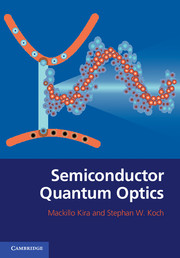Book contents
- Frontmatter
- Contents
- Preface
- 1 Central concepts in classical mechanics
- 2 Central concepts in classical electromagnetism
- 3 Central concepts in quantum mechanics
- 4 Central concepts in stationary quantum theory
- 5 Central concepts in measurement theory
- 6 Wigner's phase-space representation
- 7 Hamiltonian formulation of classical electrodynamics
- 8 System Hamiltonian of classical electrodynamics
- 9 System Hamiltonian in the generalized Coulomb gauge
- 10 Quantization of light and matter
- 11 Quasiparticles in semiconductors
- 12 Band structure of solids
- 13 Interactions in semiconductors
- 14 Generic quantum dynamics
- 15 Cluster-expansion representation of the quantum dynamics
- 16 Simple many-body systems
- 17 Hierarchy problem for dipole systems
- 18 Two-level approximation for optical transitions
- 19 Self-consistent extension of the two-level approach
- 20 Dissipative extension of the two-level approach
- 21 Quantum-optical extension of the two-level approach
- 22 Quantum dynamics of two-level system
- 23 Spectroscopy and quantum-optical correlations
- 24 General aspects of semiconductor optics
- 25 Introductory semiconductor optics
- 26 Maxwell-semiconductor Bloch equations
- 27 Coherent vs. incoherent excitons
- 28 Semiconductor luminescence equations
- 29 Many-body aspects of excitonic luminescence
- 30 Advanced semiconductor quantum optics
- Appendix Conservation laws for the transfer matrix
- Index
- References
15 - Cluster-expansion representation of the quantum dynamics
Published online by Cambridge University Press: 05 January 2012
- Frontmatter
- Contents
- Preface
- 1 Central concepts in classical mechanics
- 2 Central concepts in classical electromagnetism
- 3 Central concepts in quantum mechanics
- 4 Central concepts in stationary quantum theory
- 5 Central concepts in measurement theory
- 6 Wigner's phase-space representation
- 7 Hamiltonian formulation of classical electrodynamics
- 8 System Hamiltonian of classical electrodynamics
- 9 System Hamiltonian in the generalized Coulomb gauge
- 10 Quantization of light and matter
- 11 Quasiparticles in semiconductors
- 12 Band structure of solids
- 13 Interactions in semiconductors
- 14 Generic quantum dynamics
- 15 Cluster-expansion representation of the quantum dynamics
- 16 Simple many-body systems
- 17 Hierarchy problem for dipole systems
- 18 Two-level approximation for optical transitions
- 19 Self-consistent extension of the two-level approach
- 20 Dissipative extension of the two-level approach
- 21 Quantum-optical extension of the two-level approach
- 22 Quantum dynamics of two-level system
- 23 Spectroscopy and quantum-optical correlations
- 24 General aspects of semiconductor optics
- 25 Introductory semiconductor optics
- 26 Maxwell-semiconductor Bloch equations
- 27 Coherent vs. incoherent excitons
- 28 Semiconductor luminescence equations
- 29 Many-body aspects of excitonic luminescence
- 30 Advanced semiconductor quantum optics
- Appendix Conservation laws for the transfer matrix
- Index
- References
Summary
In this book, we encounter the hierarchy problem when we apply the equation-of-motion technique to analyze the quantum dynamics of the coupled light–matter system. To obtain systematic approximations, we use the so-called cluster-expansion method where many-body quantities are systematically grouped into cluster classes based on how important they are to the overall quantum dynamics. With increasing complexity, the clusters contain
independent single particles (singlets),
interacting pairs (doublets),
three-particle terms (triplets),
coupled four-particle contributions (quadruplets),
as well as higher-order correlations.
In this context, the N-particle concept is somewhat formal because it refers to generic N-particle expectation values 〈N〉, which may consist of an arbitrary mixture of carrier, photon, and phonon operators, as discussed in Section 14.2. In order to truncate the hierarchy problem at a given level, 〈N〉 is approximated through a functional structure that includes all clusters up to the predetermined level while all remaining clusters with a higher rank are omitted. It is natural that the corresponding approximations can be systematically improved by increasing the number of clusters included.
To the best of our knowledge, the idea of coupled-clusters approaches was first formulated by Fritz Coester and Hermann Kümmel in the 1950s to describe nuclear many-body phenomena. The approach was then modified for the needs of quantum chemistry by Jiri Cizek 1966 to deal with many-body phenomena in atoms and molecules. Currently, it is one of the most accurate methods to compute molecular eigenstates.
- Type
- Chapter
- Information
- Semiconductor Quantum Optics , pp. 304 - 323Publisher: Cambridge University PressPrint publication year: 2011

